Does Mokele-Mbembe Have A Trunk?
Posted by: Loren Coleman on July 14th, 2008
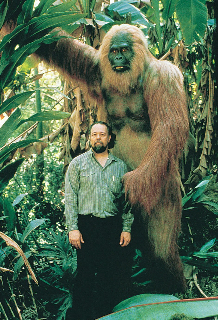
William Munns and his reconstruction of Gigantopithecus.
The famed recreator of Gigantopithecus, artist Bill Munns has opened a new window into his world and what we find inside is filled with wonders to behold. Bigfoot. Mokele-Mbembe. Saber-toothed Cats. A cryptozoo, indeed.
Munns has shared with me his news that he has uploaded and opened his Bill Munns Creature Gallery.
His continuingly upgraded site, Bill Munns Creature Gallery, represents 35 years of his work in varied fields of movie makeup effects, museum exhibit models, theme park robotics, and paleontology studies that have also included visualizations of prehistoric wildlife.
As he points out, most recently, Munns’ knowledge of fabricating creature suits has been “applied to the analysis of the classic cryptozoological mystery seen in the famous 1967 Patterson Film, and the debate of whether the figure in that film is a real Bigfoot or a human in a fabricated fur suit.”
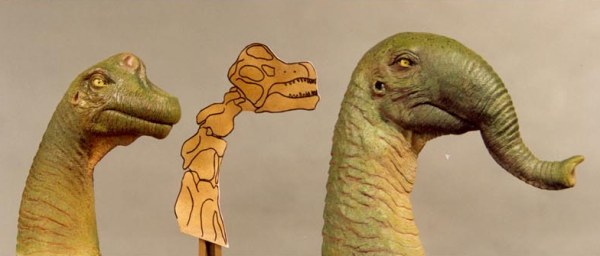
Munns also spends some time exploring an issue that directly impacts on another area of some import to cryptozoology – the possible existence of what he entitles, The Sauropod’s Trunk.
In an innovative and thoughtful bit of lateral reconceptualizing, Munns takes the past reconstructions of some dinosaurs and rethinks them.
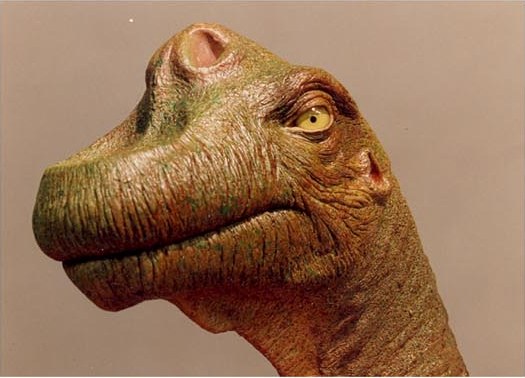
He notes his “hypothesis is born out of the unusual position of the nares (nostril openings in the skulls) of the sauropods. In the Diplodocids, the opening is at the top of the skull, between the eyes, and the opening is flush with the skull’s surface in a non-descript fashion. In the Brachiosaurids, the opening is enormous, has a high arching delicate bone in the center along the medial line, and there is a massive concavity or recessed hollow in front of the openings and directly above the teeth. As different as they both are, they have one fundamental thing in common. In both cases, the nares are at the top of the skull instead of the normal pattern of being located at the front of the skull.
“In the matter of comparative anatomy with existent species, no existent skulls are identical, but two types do have nares at the top of the skull. One group are the cetaceans (porpoise and whales). The other are the Proboscidians (elephants).”
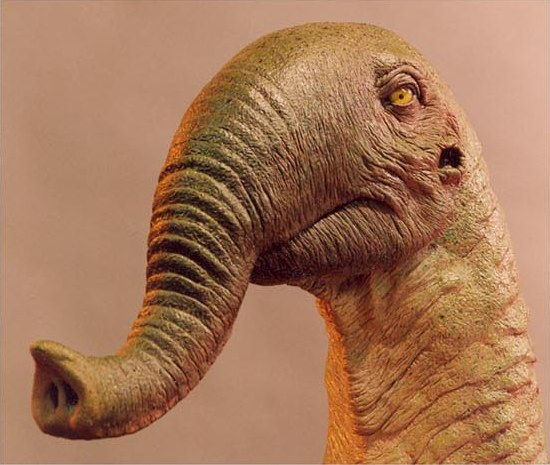
As Munns points out, interestingly, “in mammals, the presumption of a trunk is freely given to any skull with high nares.”
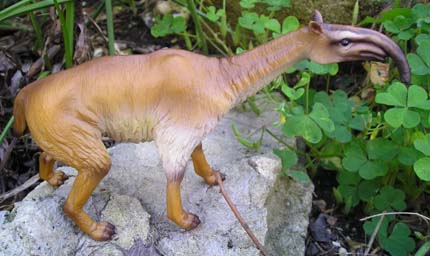
A macraucheniid litoptern produced by Schleich, pictured from Darren Naish’s private collection, and, of course, found in my International Cryptozoology Museum too.
As shown above in a model replica highly prized by myself and Darren Naish, there is a perfect instance of the trunk conception as evidenced in the fossil evidence in action.
Munns writes: “In mammalian paleontology, whenever high positioned nares are found in a skull, a trunk is presumed. And particularly, in the somewhat camel-like Macrauchenia, as described in R. Savage and M. Long’s book Mammal Evolution (pages 164 and 165), it says: ‘The cranium is short and the muzzle long with the nasal opening high on the roof of the skill (as in sauropod dinosaurs). Macraucheniids must have been very strange beasts – camel-like with a proboscis.'”
With regard to whether sauropods have trunks, Bill Munns’ rationalizations are solid, and his “vote is most emphatically yes to the trunk hypothesis.”
His imagery with regard to these dinosaurs is remarkable, as demonstrated by what he has allowed me to share on these pages.
In personal communication with Munns, this work might indeed have some relationship to the hunt for the supposed dinosaurs of the Congo, Mokele-Mbembe, as hinted in my headline. The artist has written me: “The sauropod trunk concept is interesting, in that if by some miracle, they do find a dinosaur in Africa, it might be a sauropod, and we might know the answer to the question. We can hope.”

Bill Munns works on the Gigantopithecus head.
Munns’ creations are fantastic, and just to move away from his Gigantopithecus and the sauropods for a moment, here are two samples of what he envisioned for two saber-toothed-appearing felines from the La Brea Tar Pits, Smilodon (a true saber-toothed cat of the Felidae, subfamily Machairodontinae) and Dinictis (a false saber-toothed cat of the Nimravid family).
I find Munns’ reconstructions of these cats quite beautiful:
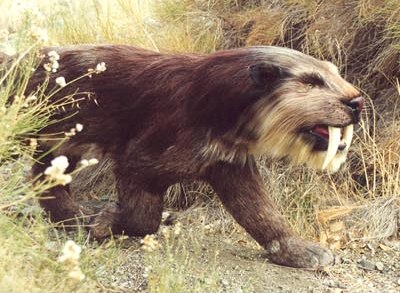


Go visit the “Bill Munns Creature Gallery” for more, including his thoughts and creature suit analyses on the Patterson-Gimlin Bigfoot film.
^^^^^^^^^^^^^^^^^^^^^^^^^^^^^^^^^^^^^^^^^^^^^^^^^^^^
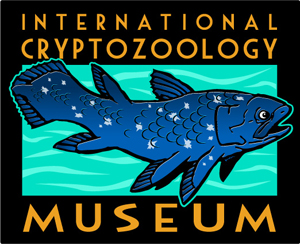
As of July 14th, over 150 different people have contributed (averaging a bit over $30 each), and the donation drive got off to a great start. Even two benefactors, at $1000 and $1050 pitched in, but donations have dropped off to nearly zero since July 3rd.
Please donate to the museum, and remember you may directly send a check, money order, or, if outside the USA, an international postal money order made out to the “International Cryptozoology Museum” ~ or in the spirit of this posting, send along your exhibition-quality models and replica animals and cryptids also as a donation – to the
International Cryptozoology Museum
c/o Loren Coleman
PO Box 360
Portland, ME 04112
Please “Save The Museum” (fuller details can be found by clicking there)! Easy-to-use donation buttons are now available here or merely by clicking the blank button below, which takes you to a donation site without you having to be a member of PayPal. Thank you, everyone!
About Loren Coleman
Loren Coleman is one of the world’s leading cryptozoologists, some say “the” leading living cryptozoologist. Certainly, he is acknowledged as the current living American researcher and writer who has most popularized cryptozoology in the late 20th and early 21st centuries.
Starting his fieldwork and investigations in 1960, after traveling and trekking extensively in pursuit of cryptozoological mysteries, Coleman began writing to share his experiences in 1969. An honorary member of Ivan T. Sanderson’s Society for the Investigation of the Unexplained in the 1970s, Coleman has been bestowed with similar honorary memberships of the North Idaho College Cryptozoology Club in 1983, and in subsequent years, that of the British Columbia Scientific Cryptozoology Club, CryptoSafari International, and other international organizations. He was also a Life Member and Benefactor of the International Society of Cryptozoology (now-defunct).
Loren Coleman’s daily blog, as a member of the Cryptomundo Team, served as an ongoing avenue of communication for the ever-growing body of cryptozoo news from 2005 through 2013. He returned as an infrequent contributor beginning Halloween week of 2015.
Coleman is the founder in 2003, and current director of the International Cryptozoology Museum in Portland, Maine.










That is very cool. I particularly like that trunked sauropod.
First time commentor; interesting shnoz on that beast. Say, what would a cetacean/proboscidian mix be? Something like Trunko?
I thought the whole “sauropods had trunks” deal was trashed a long time ago.
The trunked sauropod is incredibly suggestive, and I find the logic behind it to be sound. Has Mr. Munns discussed this hypothesis with some of his paleontologists friends? This deserves a peer-reviewed paper.
And also, the images on his website are amazing. In fact, I should advise him to put copyright watermarks on his photos, which are of course annoying but sadly necessary to protect an artist’s work.
“…this work might indeed have some relationship to the hunt for the supposed dinosaurs of the Congo, Mokele-Mbembe, as hinted in my headline.”
In all the sighting reports of Mokele-Mbembe that I’ve read, two things come to mind:
1) None of the reports or sketches or illustrations show any kind of trunk, yet the locals immediately agree on their accurate resemblance to the creature they saw.
2) Most of those accounts describe and show the beast in water, like a big hippo with a long neck and tail – if that’s true, to what advantage would a trunk have evolved?
Elephants need a trunk to bring ground or aerial vegetation to their mouths, because their short necks limit their head’s mobility.
Giraffes, on the other neck, can get right up (or down) to where the goodies are growing, so they get along fine with a short nose.
I agree that trunked sauropod is interesting. Ugly, I must say…but interesting. The reconstructed cats are indeed gorgeous. Good show, Mr. Munns!!!
Fascinating stuff! Thanks for passing this along!
The idea of trunks on sauropods reminds me a bit of another variant depiction I’ve seen in the past of dinosaurs. In particular this had to do with ceratopsians, and the author had the idea that the large ‘frills’ were muscle attachment areas for the dino’s jaw and neck muscles. His reconstructions were also quite striking, as the creatures in question, rather than having an ‘armored frill’, instead had a larger looking head and much heavier neck, with horns if any just protruding from the skin. If I recall correctly the book was titled ‘Archosaurs’, but I forget the author.
I think the one with the trunk is cool looking!
General comment:
I believe a minor correction is in order about the cat, Dinictis. It may not have been found in the La Brea Pits of Los Angeles, as Smilodon was, but it is known from finds in South Dakota.
For Elasmosaurus:
I don’t know that the trunk idea has been “trashed” as you say, but those who do not subscribe to it usually cite the apparent absense of muscle attachment indicators, as well as a lack of small holes in the jaws of the skull (which carry the nerves to the usual lip muscles). As much as I know, these are the main arguments against a possible trunk.
I will readily concede the trunk is a hypothesis, nothing more, but I feel the concept is worthy of further investigation.
Bill
Because of the strangeness of the brachiosaur’s skull, is it possible these primordial giants had a sort of upward pointing trunk, maybe not quite as flexible as say an elephant’s trunk? If the Mokele-Mbembes were real, they were brachiosaurs, and they had these sort of trunks, perhaps it could explain Artist’s question. I’ve heard about these dismal dragons supposedly submerging themselves completely under water – could the trunk be used like a snorkel?
Hmm this is great. 🙂
Job 41:15- 24
15 “Take a look at Behemoth, which I made, just as I made you.
It eats grass like an ox.
16 See its powerful loins and the muscles of its belly.
17 Its tail is as strong as a cedar.
The sinews of its thighs are knit tightly together.
18 Its bones are tubes of bronze.
Its limbs are bars of iron.
19 It is a prime example of God’s handiwork, and only its Creator can threaten it.
20 The mountains offer it their best food, where all the wild animals play.
21 It lies under the lotus plants, hidden by the reeds in the marsh.
22 The lotus plants give it shade among the willows beside the stream.
23 It is not disturbed by the raging river, not concerned when the swelling Jordan rushes around it.
24 No one can catch it off guard or put a ring in its nose and lead it away.
Lets see.. 🙂
In other English version of the bible, it says the Behemoth is an Elephant? Well I will tell you true, Elephants Don’t have Its tail as strong as a cedar.
And if you remember, have you seen Elephants held captive? Well I have, in zoos, circuses, etc. It’s quite clear you can put a ring on an elephants nose, so how can a Behemoth be an Elephant?
Here’s a Dinosaur that’s said to be the Behemoth. The Brachiosaur. Why? Well it appears the tail Its tail is as strong as a cedar.
But I doubt it’s the Brachiosaur. Yes, I do believe it’s from a sauropod (Sauropoda), like the brachiosaur, but I think it was another type of sauropod. Forgot its name.
But Wait! Why do you think someone would say Elephant? Hmmm, when some translated the bible, may go back long ago, well who ever FIRST put elephant must of saw a drawing of an old carving of a creature that resembled an elephant that was said to be behemoth. Iif you didn’t know, there are lots of cave drawings of creatures in the past and lots of sculptures. Sso who ever translated the bible, got it’s Behemoth Source somewhere.
If He’s Right about the Trunk, that may explain why some Translators put Elephant. Due to the Fact Both Elephants and Sauropods are Large.
I’m Surprised No one in that site commented saying anything about Job 40. I think should sign up and comment lol.
🙂
now as for the Leviathan in Job 41. As i said before “Some bible” state it’s a Crocodile.
But when you think of it, no crocodiles breath fire, none of them have armor like scales, and you can kill a Crocodile by spearing it I think. But you can kill a crocodile, one way or another.
I don’t have any info about leviathan. The only info i have about the Leviathan is Job 41.
And the Animal that “MAY” likely be the leviathan is the Kronosaur.
Still as for the Trunked Sauropod, seems a Tiny bit off, due to the fact Mokele-Mbembe sightings in Africa, Witnesses never mentioned any trunk, some mentioned a horn. I forgot where i read that one.
Oh and by the way, yes Animals are Capable of Not being Seen by Humans.
There are lots a few animals I know of that’s been thought to be extinct and years years years later, it turned up that they are still alive.